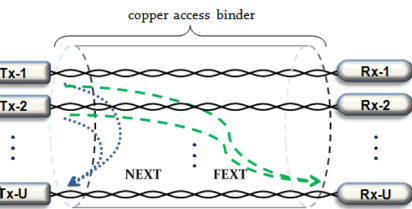Copper DSL: Enabling High-Speed Internet Access over Copper Lines
Introduction
In the world of high-speed internet access, Copper DSL (Digital Subscriber Line) has been a crucial technology that has connected millions of users to the online world. Despite the emergence of fiber optics and cable internet, Copper DSL continues to play a significant role in delivering broadband connectivity to homes and businesses. In this blog post, we will explore the concept of Copper DSL, its working principles, advantages, and limitations. We will also discuss its applications, the challenges it faces, and the future of Copper DSL in the evolving landscape of broadband communication.

- Understanding Copper DSL
Copper DSL, also known as Digital Subscriber Line, is a technology that utilizes existing copper telephone lines to deliver high-speed internet access. It is a form of broadband communication that allows simultaneous transmission of voice and data signals over the same copper infrastructure.
DSL technology revolutionized the use of copper lines by enabling much faster internet speeds compared to traditional dial-up connections. It achieves this by utilizing higher frequencies and advanced modulation techniques to transmit data alongside voice signals.
- Working Principles of Copper DSL
It employs various techniques to deliver broadband internet access over copper lines. The most common types include Asymmetric DSL (ADSL) and Very-high-bit-rate DSL (VDSL).
ADSL divides the available bandwidth into separate channels for upstream and downstream traffic. It allocates a larger portion of the bandwidth for downstream data transmission, making it suitable for applications where users primarily download data, such as web browsing and video streaming. On the other hand, VDSL provides higher symmetrical speeds, making it ideal for scenarios where both upstream and downstream data rates are essential, such as video conferencing or online gaming.
It employs modulation techniques like Discrete Multi-Tone (DMT) modulation to transmit data over different frequencies. DMT divides the available bandwidth into multiple sub-channels, each transmitting data at a specific frequency. This allows to overcome the limitations of copper lines, such as signal degradation and interference, by adapting to varying line conditions.
- Advantages of Copper DSL
It offers several advantages that have contributed to its widespread adoption:
a. Wide Coverage: Copper telephone lines have been extensively deployed, reaching both urban and rural areas. This widespread coverage makes accessible to a larger population, bridging the digital divide and providing internet access to areas where other technologies may not be readily available.
b. Compatibility: This is compatible with the existing telephone infrastructure and in-home wiring. This compatibility allows for a smooth transition from traditional voice services to high-speed internet without significant infrastructure changes or additional costs.
c. Cost-Effectiveness: It is often a more cost-effective option compared to fiber optics and cable internet. It utilizes the existing copper infrastructure, reducing the need for extensive network upgrades and installations. This cost-effectiveness makes an attractive choice for service providers and end-users, especially in areas where fiber deployment is not economically viable.
d. Reliability: Copper lines have proven to be reliable over the years, withstanding various environmental conditions. They are less susceptible to interference from electrical devices and can maintain a stable connection even over long distances.
- Limitations and Challenges
While Copper DSL has its advantages, it also faces certain limitations and challenges:
a. Distance Limitations: The quality and speed of Copper DSL deteriorate as the distance between the user and the telephone exchange increases. Copper lines have inherent resistance and attenuation properties, causing signal degradation over longer distances. As a result, users located far from the central office may experience significantly slower speeds compared to those in close proximity.
b. Bandwidth Constraints: Copper lines have limited bandwidth capacity compared to fiber optics. The available bandwidth over copper gradually decreases with distance, resulting in slower speeds for customers farther away from the central office. This limitation becomes more pronounced with the increasing demand for high-bandwidth applications like video streaming and cloud services.
c. Signal Degradation: Copper lines are susceptible to signal degradation caused by external interference, such as electromagnetic interference (EMI) and radio frequency interference (RFI). These interferences can impact the quality and stability of the internet connection, leading to slower speeds and potential service disruptions.
d. Infrastructure Upgrades: As the demand for higher internet speeds increases, Copper DSL may require infrastructure upgrades to support faster DSL technologies. Upgrading the existing copper infrastructure can be costly and time-consuming, especially in areas with extensive copper deployments. This poses a challenge for service providers looking to deliver faster broadband services.
- Applications and Future of Copper DSL
It continues to find application in various scenarios:
a. Residential Broadband: Copper DSL is widely used to provide high-speed internet access to residential users. It enables households to enjoy web browsing, email, video streaming, and other online activities.
b. Small and Medium-Sized Businesses:It offers a cost-effective solution forsmall and medium-sized businesses that require reliable internet connectivity. It allows for efficient communication, file sharing, and access to cloud-based services.
c. Remote Areas: Copper DSL plays a crucial role in connecting remote and rural areas where fiber optics infrastructure is limited. It provides internet access to communities that would otherwise be underserved or unserved.
d. Backup and Redundancy: Copper DSL can serve as a backup or redundant connection in situations where primary connections, such as fiber optics, experience outages or disruptions. It ensures continuity of internet services and minimizes downtime for businesses and individuals.
The future of Copper DSL lies in its ability to coexist with emerging technologies and adapt to changing demands. While fiber optics and cable internet continue to dominate the broadband landscape, Copper DSL will continue to serve as a viable option, especially in areas where fiber deployment is challenging or cost-prohibitive. Improvements in DSL technologies, such as vectoring and bonding, can enhance the performance and reliability of Copper DSL, mitigating some of its limitations.
Furthermore, the ongoing development of next-generation DSL technologies, such as G.fast and XG-FAST, aims to push the limits of copper infrastructure to deliver even higher broadband speeds. These advancements, combined with ongoing investments in network infrastructure, can extend the lifespan and relevance of Copper DSL in the evolving broadband ecosystem.
Conclusion
Copper DSL has played a significant role in connecting users to high-speed internet access over the existing copper telephone infrastructure. Its advantages in terms of coverage, compatibility, cost-effectiveness, and reliability have made it a popular choice for service providers and end-users. However, It also faces limitations related to distance, bandwidth, signal degradation, and infrastructure upgrades. Despite these challenges,It continues to find applications in residential, business, and remote areas, providing essential connectivity to millions of users.
While the future of broadband communication lies in fiber optics and other emerging technologies, Copper DSL will remain relevant, particularly in areas where fiber deployment is not feasible or cost-effective. Continued advancements in DSL technologies and infrastructure investments can further enhance the capabilities of Copper DSL and ensure its ongoing role in delivering high-speed internet access.
